I'm a little confused over all this talk that laserdiscs are analogue. If they are stored on an optical disc, then the data must originally be in a digital format so how exactly are they analogue? Is the digital information converted to analogue before it reaches the television somehow? Thanks.
+ Reply to Thread
Results 1 to 30 of 31
-
-
http://www.access-one.com/rjn/laser/legacy/ld96.html
BTW, Google is your friend. You are in breach of the forum rules and are being banned. Do not post false information.
You are in breach of the forum rules and are being banned. Do not post false information.
/Moderator John Q. Publik -
Tapes can hold digital data. DV, computer tape backups, for example
Discs can hold analog data. Laserdiscs, for example.Want my help? Ask here! (not via PM!)
FAQs: Best Blank Discs • Best TBCs • Best VCRs for capture • Restore VHS -
From reading that article this is how I understand it.
Laserdiscs use pits and lands for the video and audio(just like DVDs).
But the difference, is that the signal on the laserdisk is controlled by the distance between the pits and lands. Distance is analog!
Different laserdisc players can interpret these distances differently depending on their quality and accuracy.
On DVD disks the pits and lands are used for the data, therefore its either a 1 or a 0. Every DVD player will read it back exaclty the same way, there is no in between. -
The video information on laserdiscs is not digital. Here is a good description of how laserdiscs work from a 1977 Popular Science article:
"A low-power laser beam, focused to a one-micron spot, strikes the bottom surface of the aluminum disc. This highly reflective layer has a clear-plastic protective coating. The beam falls on a spiral track that consists of oblong bumps of varying lengths, with flat areas between them. The encoded picture information varies the distance between bumps. Part of the laser light is reflected from the flat area between bumps back through the optics to a light-sensitive diode that detects the TV signal.
By shifting the beam spot slightly on the spinning disc, three sophisticated servo circuits maintain focus, tracking, and proper speed. The servos sense deviations by monitoring auxiliary beams reflected from the disc. Corrections are made with electronic signals that can shift the focusing lens up or down; or, to compensate for radial (sideway) and speed errors, two mirrors positioned at right angles to each other can be pivoted to shift the beam spot.
Spacing between the bumps varies according to TV picture information. The bumps scatter the beam, but the flat, shiny aluminum area between them reflects light back through a two-way prism or mirror to a photo-diode detector. The detector circuits convert the code-like flashes from the disc into a TV signal. Tracks are less than two microns (millionths of a meter) apart. The player can endlessly freeze a TV frame, show fast or slow-motion pictures, and display on the screen the number of up to 54,000 separate coded frames."
There you have it. The varying lengths of the lands and pits are the key to how analog composite video information is stored on a laserdisc. -
For the record, the digital data on a DVD is stored in analog format.
ICBM target coordinates:
26° 14' 10.16"N -- 80° 16' 0.91"W -
Don't you mean "Is storing AN analog format"?Originally Posted by SLK001
-
It was my understanding that the video data on a Laserdisc is taken from an analogue master, such as a TV broadcast reel or similar. A source little different from VHS, in other words. In fact, I've read in many a place that the only thing digital on Laserdisc is some of the soundtrack information.
DVD differs in that the video and audio information are both taken from high-resolution digital masters. The video is taken from a high-def digital storage master (currently 1080I, which converts into PAL/NTSC standards very well). Of course, it doesn't necessarily have to be taken from such a source, but the major film studios do this because it results in a better-looking product."It's getting to the point now when I'm with you, I no longer want to have something stuck in my eye..." -
Many LD's were made from high resolution, high bandwidth masters created right from the film prints (Criterion Collection LD's for example). These are in no way similar to VHS, which is a low bandwidth, low resolution videotape format. However, laserdisc image quality does vary widely, and some look much better than others, no question about that.Originally Posted by Nilfennasion
Newer DVD's are often made from excellent digital masters as you pointed out, but many early DVD releases were not and have relatively poor quality as a result. It costs lots of money to produce a high definition digital master from film stock, so older movies are sometimes transferred to DVD from the highest quality master that is available. -
No. The data is stored in a format similar to that of the Laserdisc. The Laserdisc's laser detector gives an output that is analog that can basically go right to a video monitor. The DVD's laser detector gives an output that is also analog, but it looks like a digital data stream (ie, has higher voltage regions and lower voltage regions). This data stream is then run through a level detector that gives an output that is pure digital ("1"s and "0"s).Originally Posted by BSR
Just because the disks are silver and have a laser doesn't mean that there are "1"s and "0"s on them. Just like your hard disks store the data in analog format.
The only format that I know of that stores data directly in digital format is the flash disks.ICBM target coordinates:
26° 14' 10.16"N -- 80° 16' 0.91"W -
You are correct, but I think you are just being picky. I could be picky and point out that even a flash disk is analog. It is just voltages and thresholds that matter, all 'digital' electronics is the same in that respect.Originally Posted by SLK001There are 10 kinds of people in this world. Those that understand binary...
-
If you guys get that picky about what is digital than the only true Digital would be mechanical Computer hardware.
Any time electricity is involved (processors built with tranistors or vacuum tubes) it is not truely 0's and 1's., but Peaks and valleys the signify 0's and 1's. -
Lets not be dissing analog technology nowOriginally Posted by Nilfennasion
 There are 1970's analog video recorders that record in higher quality than DVD or D1.
There are 1970's analog video recorders that record in higher quality than DVD or D1.
Mixed digital and analog video technology has been used in the broadcast and film industry since the early 1970's even back to the 60's for subsystems. Modern digital video began with the development of the digital TBC (by CVS) and the FrameSync (by NEC) in 1972-73. The TBC stabilized analog video tape recorders. The frame sync allowed non-synchronized video (e.g. satellites or live microwaved cameras) to be switched live without the home TV loosing vertical lock. It's an interesting history.
As far as film goes there was and still is a hierarchy for electronic masters. Mid level electronic masters were the broadcast videotape standard of the day. These were 2"Quad, 1"TypeC and then D1 (CCIR-601 4:2:2 720x480 uncompressed digital) that is the basis for today's DVD. The D1 format has been around since the mid 80's for recording digital masters from Rank Cintel flying spot film scanners in a full digital process.
This is still considered mid level because there has always been parallel analog and digital master technologies that allow much higher resolution transfers used in film production.
Since the late 80's high quality laserdiscs were often mastered from these D1 masters so the quality can be very high. Laserdiscs do suffer from NTSC or PAL encoding artifacts but there was no compression. DVDs are mastered from the same D1 masters but they suffer MPeg2 compression artifacts.
Laserdiscs made in the late 90's contained the same Dobly Digital 5.1 AC-3 surround audio that became standard on DVDs. Also in the late 90's HDTV video recorders started to be used for film transfers and these masters will be used for next year's HD-DVD and Blue-Ray HDTV DVD products. -
If memory serves, the CVS TBC was not a frame sync; it only buffered two lines. And it was incredibly expensive at that.
What was the 70's analog video format you're referring to that was superior to D1, and how was it superior? -
Sorry, misread your post.
BTW, I once saw a gigantic Ampex quad recorder at ABC Hollywood that had a massive analog TBC. The thing had drawer after drawer of crystal delays. It would detect timing errors as the heads spun, and, on the fly, route the raw signal through the amount of crystal needed to sync the output with the main station subcarrier. -
The CVS 500 was 2 line I think but its significance was that allowed cheap helical scan VTRs to achieve broadcast stability. This triggered the concept of a broadcast quality camcorder that launched electronic news gathering (ENG) using video recording instead of film.
The "1974 super VTR" was the all analog (even the TBC) IVC-9000 which was paired with the Rank Cintel flying spot film scanner. It recorded NTSC or PAL on 2" Helical tape and had something like a 8-9MHz bandwidth. D1 has a 6.75 MHz (nyquist max) luminance bandwidth. -
Wow, you're right. I remember reading about the IVC-9000. Giant black beast if I'm recalling correctly. Can't believe I actually had occasion to access those brain cells again.

By any chance, do you remember the old Ampex quad that had some bizarrely-fast cueing speed, by virtue of a vacuum capstan? Had a -1 in the name, I think? The V-1, or T-1, or something? If so, do you remember how fast it could wind a quad reel? I remember my mind just boggling at it, but the details now escape me. -
Yes and those massive "glass" delays used for the Quads had much less than one line of correction. To compensate, the servos had to reach extremely tight control for all the motors. That is why those things cost a quarter million 1970 dollars (about $2.5-3 million in todays dollars).Originally Posted by That Bastid
One of the $200 DVD recorders at Walmart today can in most ways (not all) outperform that machine. -
The IVC-9000 was blue and silver like the Rank. Rank Cintel was an investor partner in the project.Originally Posted by That Bastid
The Ampex machine was probably an AVR1, the robotic cassette version (commercial player) was the ACR25. Many of the same Ampex engineers that did the AVR1 moved to IVC to do the IVC-9000.
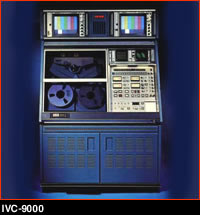
IVC-9000 2" (Helical technology like today's VCR and camcoder)

Ampex AVR1 (Quadruplex technology)
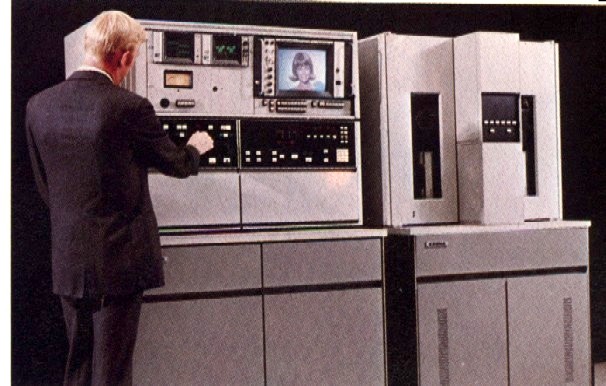
Ampex ACR25
All this was before 1974 folks
-
The AVR1 Quadruplex was close to the last of the brute force all analog technology. The digital TBC allowed cheaper mechanical transports and made the video path partially digital. From that beginning all the current digital video technology grew.
RIP Quads
http://sky.prohosting.com/vtrs/vtr.htm
Early Computer Video Editing
http://www.sssm.com/editing/museum/ -
First, thanks for the history lesson. It's fascinating to see just how old some technologies really are.

Second, don't knock MPEG-2 compression. When it goes wrong, it sure can produce some horrible results, but with the right encoder, it can produce some beautiful ones, too. Most DVDs that look worse or at least mediocre compared to a Laserdisc of the same film are produced by studios or producers who, to put it bluntly, don't seem to care (the early Australian releases of Die Hard and its sequels being a case in point).
Third, A $200 DVD recorder outperforming a 197X-generation studio behemoth in most respects is not surprising. It is a good example of Moore's Law at work. "It's getting to the point now when I'm with you, I no longer want to have something stuck in my eye..."
"It's getting to the point now when I'm with you, I no longer want to have something stuck in my eye..." -
I agree in all respects but you really need to see how good the D1 master looks to appreciate the MPeg2 compromises. That said, Mpeg2 is is great and helps get us that $2 milion result for $200.
BTW, the first D1 machine (1984-85) sold for $200k plus options.
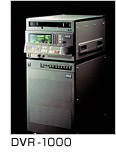
Sony DVR-1000 -
Well, quad dates back to well before the machines in the pictures. edDV will know, but I'm guessing mid-60's? Early 60's, perhaps? I know the old Laugh-In shows were painstakingly video-edited with razorblades...talk about your analog technology!It's fascinating to see just how old some technologies really are.
-
Being that MPEG-2 is variable, the compromises used with it also vary from disc to disc. Although I haven't seen a D1, it seems apparent to me that they made the early DVD releases as average as possible so as not to get expectations too high.
 "It's getting to the point now when I'm with you, I no longer want to have something stuck in my eye..."
"It's getting to the point now when I'm with you, I no longer want to have something stuck in my eye..." -
Ahh you mean the Ampex VR-1000 introduced in 1956 and famous for recording the Nixon Kitchen debates in a Moscow trade show.
http://images.google.com/imgres?imgurl=http://www.lionlamb.us/quad/vrx1000.jpg&imgrefu...D%26safe%3Doff
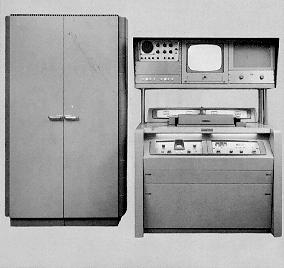
Ampex VR-1000
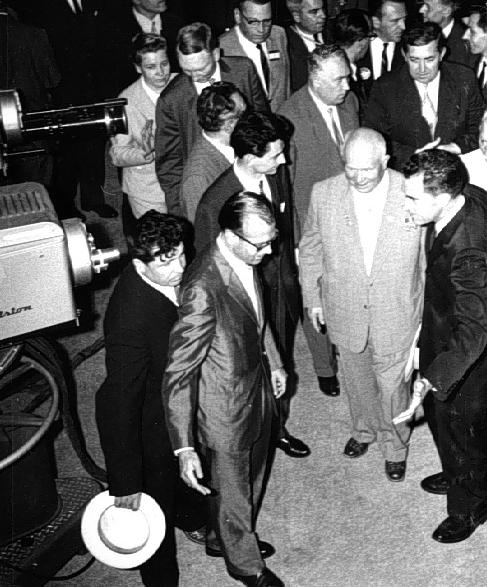
http://images.google.com/imgres?imgurl=http://homestudio.thing.net/revue/content/Nixon...D%26safe%3Doff
"
A scene from the famous "Kitchen Debate" between then Vice President Nixon and Soviet Premier Khrushchev in Moscow (July 1959). The encounter was captured on videotape and replayed later to 72 million American home TV viewers. The event brought prominence to the technology of "live" playback from a strip of magnetic tape. " -
Yes. I believe (correct me if I'm wrong) that an engineering intern on the original Ampex unit was a bright-eyed young Brit named Roy (Ray?) Dolby.
-
oops, I screwed that up Html is not my native language.Originally Posted by edDV
Yes Ray Dolby was one of the original team.
The folks on this forum should bow to these guys ... We are not worthy !
http://www.videointerchange.com/formathistory.htm
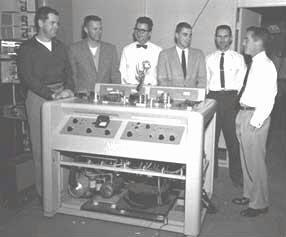
VR-1000 design group
Left to right: Charles Anderson, Shelby Henderson, Alex Maxey,
Ray Dolby, Fred Pfost and Charles Ginsburg -
Hey, edDV, you'll get a kick out of this... Years ago, I went to Harry Lubcke's house in the Hollywood Hills to interview him. Who was Harry Lubcke? Harry was an early pioneer of television, dating back to the days when, if you wanted to do tv, you had to build your own equipment, invent your own format and figure out how to modulate a radio signal with it. Harry talked a rich Cadillac dealer into funding his experiments, and so when W6XA0 Channel 1 (yes, 1...later taken back by the US govt. for civil defense) went on the air, it was from the top floor of a downtown LA Caddy dealership. It later moved to the Hollywood Hills, and the then-magnificent studios can still be seen in most shots of the Hollywood sign (it's the building on the top of that ridge.) It's now just a microwave relay station, but there's a soundstage in that building big enough to play tennis in, and Harry did in fact program live in-studio tennis matches from that studio.
How old-school was Harry? Get this...Harry invented composite sync, which in 1982 he was still calling by his original term, "blacker-than-black synchronization." Before Harry came up with it, tv only worked if the audience member's set happened to be attached to the same generator as the TV station's cameras (since the whole chain was locked only to the powerline's AC wave.) This was a problem for Harry and W6XAO, because while Los Angeles is in front of that hill, Burbank is behind it...and Burbank is a separate city with its own generating station. Harry's insight meant he could broadcast to TV sets on both sides of the mountain. (To prove to the skeptical press that he had pulled it off, he chartered an airplane, put a tv in it, and flew the journalists around LA while they watched tv in the plane -- the ultimate "look, no wires" demo.)
Harry is also the guy who named the Emmy award, though his original suggestion was to call it the "Immy." No, not an old girlfriend...Harry, the ultimate tech dork and founding president of the TV Academy, was naming the award after the Image Orthicon tube (the original pickup device.) Wiser heads told him to change the 'I" to "E." -
Great story and there are so many more like it. Broadcast technology was so complex in those days and the true pioneers have not received anywhere near the tribute that has gone to computer pioneers. I've been honored to shake the hands of Vladimir Zworykin and Akio Morita before they died. There is a history to be written.
-
Definitely cool and very interesting history you are sharing here with us!
Similar Threads
-
analogue video enhancer?
By Jac26 in forum MacReplies: 16Last Post: 4th Jul 2009, 08:14 -
Connecting Analogue hd lcd tv to freesat
By keats in forum Newbie / General discussionsReplies: 0Last Post: 26th Jun 2009, 13:30 -
Analogue Capture problems
By Lensmeister in forum Capturing and VCRReplies: 4Last Post: 8th Feb 2009, 06:20 -
Capture analogue (eg. VHS, analogue camcorder) - AVI or MPEG?
By ManUtdFans in forum Capturing and VCRReplies: 3Last Post: 18th Jan 2009, 19:29 -
Analogue Capture
By Sonnyt in forum Capturing and VCRReplies: 3Last Post: 26th Mar 2008, 20:49




 Quote
Quote